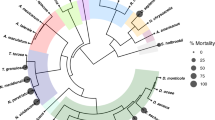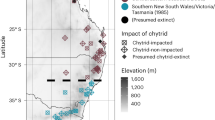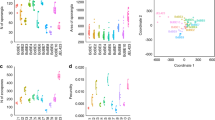Abstract
The recent arrival of Batrachochytrium salamandrivorans in Europe was followed by rapid expansion of its geographical distribution and host range, confirming the unprecedented threat that this chytrid fungus poses to western Palaearctic amphibians1,2. Mitigating this hazard requires a thorough understanding of the pathogen’s disease ecology that is driving the extinction process. Here, we monitored infection, disease and host population dynamics in a Belgian fire salamander (Salamandra salamandra) population for two years immediately after the first signs of infection. We show that arrival of this chytrid is associated with rapid population collapse without any sign of recovery, largely due to lack of increased resistance in the surviving salamanders and a demographic shift that prevents compensation for mortality. The pathogen adopts a dual transmission strategy, with environmentally resistant non-motile spores in addition to the motile spores identified in its sister species B. dendrobatidis. The fungus retains its virulence not only in water and soil, but also in anurans and less susceptible urodelan species that function as infection reservoirs. The combined characteristics of the disease ecology suggest that further expansion of this fungus will behave as a ‘perfect storm’ that is able to rapidly extirpate highly susceptible salamander populations across Europe.
This is a preview of subscription content, access via your institution
Access options
Access Nature and 54 other Nature Portfolio journals
Get Nature+, our best-value online-access subscription
$29.99 / 30 days
cancel any time
Subscribe to this journal
Receive 51 print issues and online access
$199.00 per year
only $3.90 per issue
Buy this article
- Purchase on Springer Link
- Instant access to full article PDF
Prices may be subject to local taxes which are calculated during checkout




Similar content being viewed by others
References
Martel, A. et al. Wildlife disease. Recent introduction of a chytrid fungus endangers Western Palearctic salamanders. Science 346, 630–631 (2014)
Spitzen-van der Sluijs, A . et al. Expanding distribution of lethal amphibian fungus Batrachochytrium salamandrivorans in Europe. Emerg. Infect. Dis. 22, 1286–1288 (2016)
Fisher, M. C. et al. Emerging fungal threats to animal, plant and ecosystem health. Nature 484, 186–194 (2012)
Martel, A. et al. Batrachochytrium salamandrivorans sp. nov. causes lethal chytridiomycosis in amphibians. Proc. Natl Acad. Sci. USA 110, 15325–15329 (2013)
Cheng, T. L., Rovito, S. M., Wake, D. B. & Vredenburg, V. T. Coincident mass extirpation of neotropical amphibians with the emergence of the infectious fungal pathogen Batrachochytrium dendrobatidis. Proc. Natl Acad. Sci. USA 108, 9502–9507 (2011)
Kim, K . & Harvell, C. D. The rise and fall of a six-year coral-fungal epizootic. Am. Nat. 164 (Suppl 5), S52–S63 (2004)
Frick, W. F. et al. An emerging disease causes regional population collapse of a common North American bat species. Science 329, 679–682 (2010)
Gross, A., Holdenrieder, O., Pautasso, M., Queloz, V. & Sieber, T. N. Hymenoscyphus pseudoalbidus, the causal agent of European ash dieback. Mol. Plant Pathol. 15, 5–21 (2014)
Garner, T. W. J. et al. Mitigating amphibian chytridiomycosis in nature. Phil. Trans. R. Soc. B 317, 20160207 (2016)
Spitzen-van der Sluijs, A . et al. Rapid enigmatic decline drives the fire salamander (Salamandra salamandra) to the edge of extinction in the Netherlands. Amph. Rept. 34, 233–239 (2013)
McMahon, T. A. et al. Amphibians acquire resistance to live and dead fungus overcoming fungal immunosuppression. Nature 511, 224–227 (2014)
Muths, E., Scherer, R. D. & Pilliod, S. D. Compensatory effects of recruitment and survival when amphibian populations are perturbed by disease. J. Appl. Ecol. 48, 873–879 (2011)
Schmidt, B. R., Feldmann, R. & Schaub, M. Demographic processes underlying population growth and decline in Salamandra salamandra. Conserv. Biol. 19, 1149–1156 (2005)
Seifert, D. Untersuchungen an einer ostthüringischen Population des Feuersalamanders (Salamandra salamandra). Artenschutzreport 1, 1–16 (1991)
Rosenblum, E. B., Voyles, J., Poorten, T. J. & Stajich, J. E. The deadly chytrid fungus: a story of an emerging pathogen. PLoS Pathog. 6, e1000550 (2010)
Sabino-Pinto, J. et al. First detection of the emerging fungal pathogen Batrachochytrium salamandrivorans in Germany. Amph. Rept. 36, 411–416 (2015)
Yap, T. A., Koo, M. S., Ambrose, R. F., Wake, D. B. & Vredenburg, V. T. Biodiversity. Averting a North American biodiversity crisis. Science 349, 481–482 (2015)
Price, S. J., Garner, T. W. J., Cunningham, A. A., Langton, T. E. S. & Nichols, R. A. Reconstructing the emergence of a lethal infectious disease of wildlife supports a key role for spread through translocations by humans. Proc. R. Soc. Lond. B 283, 20160952 (2016)
Blooi, M. et al. Duplex real-time PCR for rapid simultaneous detection of Batrachochytrium dendrobatidis and Batrachochytrium salamandrivorans in Amphibian samples. J. Clin. Microbiol. 51, 4173–4177 (2013)
Blooi, M. et al. Correction for Blooi et al., Duplex real-time PCR for rapid simultaneous detection of Batrachochytrium dendrobatidis and Batrachochytrium salamandrivorans in Amphibian samples. J. Clin. Microbiol. 54, 246 (2016)
Mao, J., Hedrick, R. P. & Chinchar, V. G. Molecular characterization, sequence analysis, and taxonomic position of newly isolated fish iridoviruses. Virology 229, 212–220 (1997)
Williams, B. K., Nichols, J. D. & Conroy, M. J. Analysis and management of animal populations. (Academic Press, 2002)
Lebreton, J. D., Nichols, J. D., Barker, R. J., Pradel, R. & Spendelow, J. A. Modeling individual animal histories with multistate capture–recapture models. Adv. Ecol. Res. 41, 87–173 (2009)
Kéry, M. & Schaub, M. Bayesian population analyzing using WinBUGS – a hierarchical perspective (Academic Press, 2012)
Plummer, M. JAGS: a program for analyzing of Bayesian graphical models using Gibbs sampling. In Proc. 3rd International Workshop on Distributed Statistical Computing ( Hornik, K ., Leisch, F. & Zeileis, A., 2003)
Blooi, M. et al. Treatment of urodelans based on temperature dependent infection dynamics of Batrachochytrium salamandrivorans. Sci. Rep. 5, 8037 (2015)
Schmeller, D. S. et al. Microscopic aquatic predators strongly affect infection dynamics of a globally emerged pathogen. Curr. Biol. 24, 176–180 (2014)
Dail, D. & Madsen, L. Models for estimating abundance from repeated counts of an open metapopulation. Biometrics 67, 577–587 (2011)
Acknowledgements
The technical assistance of M. Claeys and M. Couvreur is appreciated. K. Roelants kindly provided the artwork. This research is supported by Ghent University Special research fund (GOA 01G02416 and BOF01J030313) and by the Research Foundation Flanders (FWO) (G007016N, FWO16/PDO/019, FWO12/ASP/210).
Author information
Authors and Affiliations
Contributions
A.M., G.S. and F.P. designed the research. A.M., G.S., L.O.R., S.V.P., F.P., C.A., A.L., T.K. and W.B. carried out the research. A.M., F.P., G.S., S.C., B.R.S., M.S., L.O.R. and F.H. analysed the data. A.M., F.B., G.S., B.R.S. and F.P. wrote the paper with input from all other authors.
Corresponding author
Ethics declarations
Competing interests
The authors declare no competing financial interests.
Additional information
Reviewer Information Nature thanks A. Dobson, M. Fisher and B. Han for their contribution to the peer review of this work.
Publisher's note: Springer Nature remains neutral with regard to jurisdictional claims in published maps and institutional affiliations.
Extended data figures and tables
Extended Data Figure 1 B. salamandrivorans GE loads in soil.
To investigate whether B. salamandrivorans can be detected in terrestrial environments, soil samples were taken in the close vicinity of experimentally infected animals (experimental samples) and naturally infected salamanders in the Robertville outbreak area (outbreak samples). Error bars depict s.d.
Extended Data Figure 2 B. salamandrivorans GE loads detection in experimentally infected soil, incubated at 4 °C and 15 °C.
Error bars depict s.d.
Supplementary information
In vitro culture of Batrachochytrium salamandrivorans cultured in TghL broth at 15°C
A sporulating zoosporangium, motile spores and floating encysted spores are shown at 400x magnification. This video was recorded through an Olympus IX50 inverted microscope using a videocapture plugin in ImageJ. (MP4 5759 kb)
Rights and permissions
About this article
Cite this article
Stegen, G., Pasmans, F., Schmidt, B. et al. Drivers of salamander extirpation mediated by Batrachochytrium salamandrivorans. Nature 544, 353–356 (2017). https://doi.org/10.1038/nature22059
Received:
Accepted:
Published:
Issue Date:
DOI: https://doi.org/10.1038/nature22059
This article is cited by
-
eDNA-based monitoring of Batrachochytrium dendrobatidis and Batrachochytrium salamandrivorans with ddPCR in Luxembourg ponds: taking signals below the Limit of Detection (LOD) into account
BMC Ecology and Evolution (2024)
-
Loss of amphibian species alters periphyton communities in montane ponds
Hydrobiologia (2024)
-
The two chytrid pathogens of amphibians in Eurasia—climatic niches and future expansion
BMC Ecology and Evolution (2023)
-
United States amphibian imports pose a disease risk to salamanders despite Lacey Act regulations
Communications Earth & Environment (2023)
-
Disease state associated with chronic toe lesions in hellbenders may alter anti-chytrid skin defenses
Scientific Reports (2023)
Comments
By submitting a comment you agree to abide by our Terms and Community Guidelines. If you find something abusive or that does not comply with our terms or guidelines please flag it as inappropriate.



